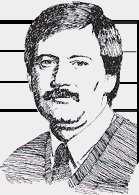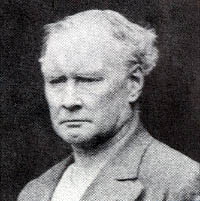Vol. 17 No. 10
October, 1987
|
Stay Safe in 87
|
|

Whymper's Antics
Fueled Many a
Conversation
|

Dave Jones
|
| |

Edward Whymper.
|
The Rocky Mountains have always attracted their fair share of eccentrics, and
more than a few have been associated over the years with Canadian Pacific. But nobody was ready for Edward Whymper
when he arrived at the company's hotel at Field, B.C., in the summer of 1901.
Granted, Whymper was a highly-respected alpinist in Europe, where he was known as the conqueror of the
Matterhorn, having been the first man to make a successful ascent of that formidable peak in the Swiss Alps. But four
men had died on that expedition, and although he had achieved further successes in his climbing career, he had never
been able to completely rid himself of the rumors that he was somehow responsible for their tragic demise.
For the CPR, however, Whymper was an ideal instrument to promote the notion of the Canadian Rockies as a tourist's
paradise - "Fifty Switzerlands in One".
ARRIVAL HERALDED WITH MUCH PUBLICITY
Whymper's arrival in Canada, along with four Swiss guides, was heralded with much publicity, and when his destination
was disclosed, the speculation was that he might try for the first ascent of Mount Assiniboine, known as the
Matterhorn of the Rockies.
The reality, as it turned out, was somewhat less spectacular.
Although several first ascents were made by Whymper and his guides up Stanley Peak, Mount Whymper, and Storm
Mountain, among others, all were rather tame and were not received in climbing circles as great achievements. One
guide, Christian Klucker, concluded that Whymper was there merely as a propaganda instrument of the CPR, recalling
in self-depreciating terms that "my greatest feat was to climb a tree in the primeval forest to
see where on earth we were".
For his own part Whymper had considerable difficulty getting along with his guides, the local outfitters, train and
hotel staffs, and just about anybody else with whom he came in contact.
A Banff outfitter, Robert E. Campbell, quotes Whymper's daily allowance on the trail as "one bottle of Scotch
and ten pints of ale".
RENAMED THE DAYS OF THE WEEK
Throughout the 1901 season, and again during his return as a consultant for the CPR in 1903, 1904, and 1905, Whymper
made his headquarters at Mount Stephen House in Field, B.C.
Although he often heaped scorn on the hotel staff along with his fellow patrons, in his more lucid moments he really
seemed to have had a soft spot for the place, as he related in his diaries: "No intimation was given to
me that I should find Field a charming place, and it has been a pleasant surprise to discover in the heart of the
Rocky Mountains a hotel which is all that a reasonable person can desire, in the midst of attractive scenery".
Sometimes long spells of bad weather confined Whymper to his room, where he found solace in recording lists of
complaints in his ever-present journals. Even the days of the week were subjected to his scorn, having
been renamed Stormday, Rainday, Mistday, Hailday, Thunderday, Snowday, and Sleetday.
His interest in, and collection of, the region's flora and fauna was one of the positive aspects of his Canadian
sojourns, and he returned to Europe after his first season with an impressive array of fossils, botanical specimens,
birds, insects, and animal skins.
He gave a captured young eagle to an aviary in Vancouver. Arriving at the CPR station in Banff, with the bird in a
cage, he attempted to persuade the agent to transport the eagle free, as company regulations stated that infants
under five years of age were to be conveyed without charge. A six dollar express charge was eventually settled upon.
ALPINIST HAD AN AMAZING CONSTITUTION
The remaining seasons brought little work from the railway, although some new exploration was done in the Crowsnest
Pass area and Whymper undertook a walking tour along the track between Kananaskis to Yale, a distance of about 800
kilometres.
Despite Whymper's enormous intake of alcohol, and the fact that he was already 53-years-old when he
first came to Canada, he appears to have had an amazing constitution, as he reported to the CPR:
"Although remaining in the mountains until winter had well set in, and experiencing in the heart of the Rocky
Mountains so low a temperature as 15.5 below zero, or 47.5 below the freezing point of Fahrenheit, I have not found
it even desirable to employ special dress, and have used from first to last only such ordinary summer clothing as I
wear habitually in England".
The value of Whymper's various reports to the CPR are hard to assess, as only one ( although from the most productive
year - 1901 ) has survived in the company's archives.
However, it is certain that he was involved in discovering several new passes, in putting names to a number of
prominent peaks, and in suggesting ways to make a number of local attractions more accessible to tourists and
sportsmen.
As a business venture, Edward Whymper's endeavors in the employ of the railway didn't amount to much, but he did
leave the locals with something to talk about.
This CP Rail News article is copyright
1987 by the Canadian Pacific Railway and is reprinted here with
their permission. All photographs, logos, and trademarks are the property of the Canadian Pacific Railway
Company.
|